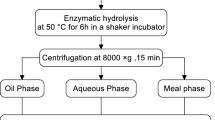Abstract
The use of enzyme-assisted partial hydrolysis as a preextraction treatment in a rural shea fat extraction process to improve upon the extraction rates of the process was explored following an observed possibility in a preliminary investigation. Finely ground shea kernel meal samples were mixed with water in predetermined ratios and heated to inactivate any enzymes present. A crude protease and an enzyme with both hemicellulase and cellulase activities were added and mixed, also in predetermined concentrations. The suspensions were incubated in a waterbath shaker at temperatures ranging from 30 to 45°C for specified periods of time. The treated meal samples were then extracted using an adapted traditional aqueous extraction process. At optimum meal-to-water ratio of 1:2, enzyme concentration of 1%, the natural pH of the meal (about 5.3), and incubation time of 4 h, the enzyme treatment increased the extraction rate from about 40% in the typical traditional system (control) to about 75%, of the total fat content (estimated by the Soxhlet method). The enzyme-treated meal samples were very easy to extract as there was no need to cream or whip out the fat, as is laboriously done in the traditional process. The extracted fat samples had apparently less unsaponifiable matter content and slightly less free fatty acid content and peroxide value, compared to samples from the typical traditional process and, in some cases, the Soxhlet extracted samples. The observations confirmed the results of the preliminary investigations and suggest that the enzyme-assisted preextraction treatment could significantly improve upon the aqueous shea fat extraction process.
Similar content being viewed by others
References
Addo Consultants,A Study of the Oil Palm Industry in Ghana, J.S. Addo and Consultants, Opeibea House, Accra, 1989.
Tano-Debrah, K., and Y. Ohta,J. Am. Oil Chem. Soc. 71:979 (1993).
Ata, J.K.B.A., The Study of the Shea Kernel in Relation to the Traditional Process of Shea Fat, Ph.D. Thesis, University of Ghana, Legon-Accra, 1978.
Salunkhe, D.K., and B.B. Desai,Post-Harvest Biotechnology of Oilseeds, CRC Press Inc., Boca Raton, 1986, pp. 204–205.
United Nations Development Fund for Women (UNIFEM),Oil Extraction. Food Cycle Technology Source Books, UNIFEM, New York, 1987.
Cornelius, J.A.,Processing of Palm Fruit and Its Products, Tropical Products Institute, GA 149, 1983.
Graille, J., M. Pina and D. Montet,Oleagineux 43:188 (1988).
Bailey, A.E.,Industrial Oils and Fats Products, Interscience Publishers Inc., New York, 1951.
Stork, G.,Stork Palm Oil Review:1, 6 (1960).
Smith, D.D., Y.C. Agrawal, B.C. Sarkar and B.P.N. Singh,J. Am. Oil Chem. Soc. 70:885 (1993).
Sosulski, K., and F.W. Sosulski, Ibid.:825 (1993).
Sosulski, E., F.W. Sosulski and E. Coxworth, Ibid.:357 (1988).
McGlone, O.C., C. A Lopez-Munguia and J.C. Carter,J. Food Sci. 51:695 (1986).
Pesquet, J.J.,Aproma/Bimonthly Review, Nos. 27–29 (1992).
Tano-Debrah, K., Traditional Palm Kernel Oil Processing in Ghana: Process and Product Characteristics, M.Phil. Thesis, University of Ghana, Legon-Accra, 1992.
Aye, F.O., and D. Adomako,Processing of Shea Fruits, Rep. Cocoa Research Institute, Ghana, 1986/87, 1987.
Dawson, R.M.C., D.C. Elliot, W.H. Elliot and K.M. Jones,Data for Biochemical Research, 2nd edn., Oxford University Press, New York, 1969, p. 486.
Official Methods of Analysis of the Association of Official Analytical Chemists (AOAC), Association of Official Analytical Chemists, Washington, D.C., 1984, pp. 507–509.
Ghana Cocoa Board,Report on Shea Nut Processing, Ghana, 1992.
Technology Consultancy Centre (TCC),Proposal for the Prototype Phase of the Centre’s Shea Butter Extraction Project, TCC, University of Science and Technology, Kumasi-Ghana, undated.
Adjei, D.A., The Characteristics ofAgbelima (cessara dough) Inoculum, B.S. dissertation, University of Ghana, Legon, 1990.
Demuyarko, B., Exploitation of Ghanaian Raw Materials in Tropical Beer Brewing, Ph.D. Thesis, Hiroshima University, Japan, 1994.
Campbell-Platt, G.,Fermented Foods of the World, A Dictionary Guide, Butterwoths, London, 1987, p. 161.
Author information
Authors and Affiliations
Additional information
An erratum to this article is available at http://dx.doi.org/10.1007/BF02638866.
About this article
Cite this article
Tano-Debrah, K., Ohta, Y. Enzyme-assisted aqueous extraction of shea fat: A rural approach. J Am Oil Chem Soc 72, 251–256 (1995). https://doi.org/10.1007/BF02638908
Received:
Accepted:
Issue Date:
DOI: https://doi.org/10.1007/BF02638908




